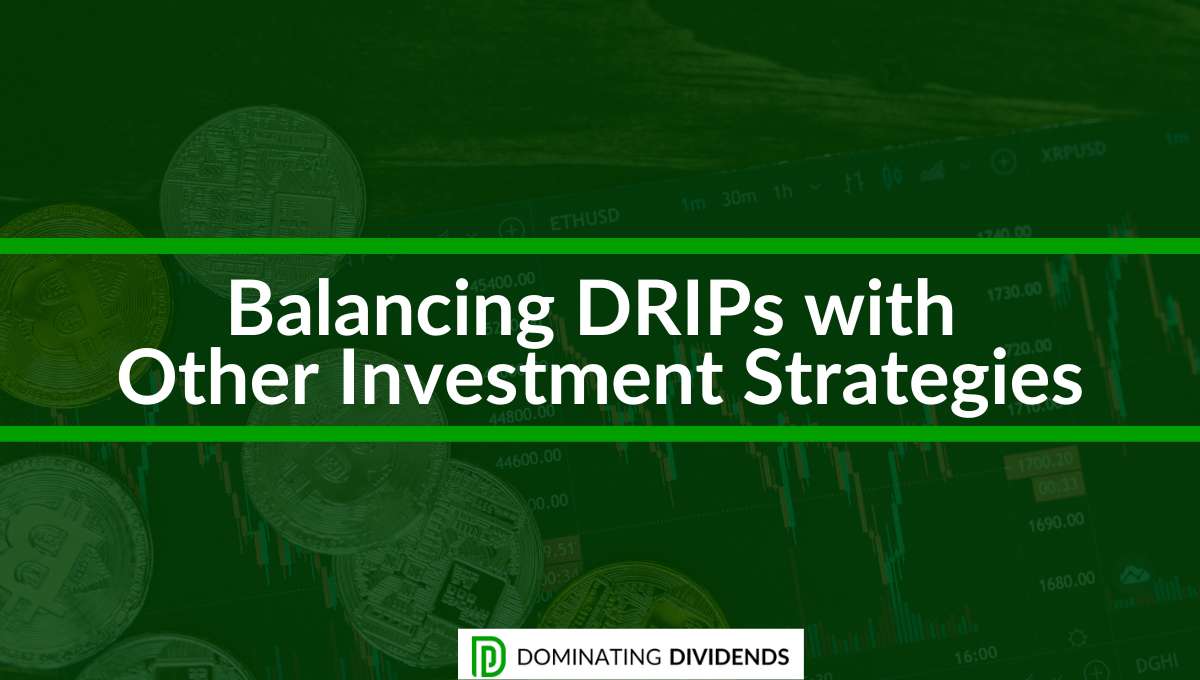DRIP Balance: Integrating with Your Other Investment Plans!

Understanding DRIPs
As seasoned investment portfolio managers, we often emphasize the importance of diversification. Among the myriad of strategies, one that stands out for its compound growth potential is the Dividend Reinvestment Plan, commonly known as a DRIP. It’s a vehicle that allows investors to automatically reinvest their cash dividends into more shares of the company’s stock.

We find that DRIPs offer a convenient and cost-effective method for increasing your stake in a company. By reinvesting dividends, you’re essentially compounding your investment without having to commit any additional funds. This strategy leverages the power of compounding, which we see time and again as a key to long-term wealth accumulation.
Here’s a quick look at how DRIPs can enhance a portfolio:
| Advantage | Explanation |
|---|---|
| Automatic Investment | Purchases additional shares automatically, ensuring you don’t miss any compounding opportunities. |
| Dollar-Cost Averaging | Spreads out the purchase price over time, potentially reducing the impact of market volatility. |
| Commission-Free | Often, purchases made through DRIPs come without broker fees, saving money. |
It’s crucial to understand that DRIPs are not immune to market risks. Just like any other investment, the value of your reinvested dividends will fluctuate with the market.
Nevertheless, our collective experience reinforces that for long-term investors who value gradual growth and are less concerned with short-term market movements, DRIPs can serve as a profoundly effective component in a diversified portfolio.
Always remember, we’re here to weigh these factors alongside you and tailor an investment strategy that aligns with your financial goals.
Comparing DRIPs with Stocks

As we explore the advantages and challenges of Dividend Reinvestment Plans (DRIPs) compared to direct stock investments, it’s essential to understand the unique aspects that DRIPs bring to our investment strategy, particularly concerning risk, growth, and liquidity.
Risk Factors
When we look at DRIPs, our risk is typically lower due to the nature of investing in dividend-paying companies that are often more stable. Stock investments can be more volatile, with prices fluctuating based on market sentiment and earnings reports.
With DRIPs, the automatic reinvestment can also help us in dollar-cost averaging, which reduces the risk of investing a large amount at an inopportune time.
| Investment Type | Risk Level | Factors Influencing Risk |
|---|---|---|
| DRIPs | Generally Lower | Stable dividends, dollar-cost averaging |
| Stocks | Can be Higher | Market volatility, company performance |
Growth Potential
DRIPs can offer a steady growth trajectory as reinvested dividends purchase more shares over time, compounding our investment.
However, individual stocks may offer higher growth potential if we select a company that experiences significant appreciation.
It’s a trade-off: DRIPs provide consistent, incremental growth, while stocks can lead to substantial gains if our stock picks prove successful.
| Investment Type | Growth Type | Growth Mechanism |
|---|---|---|
| DRIPs | Steady, Compounding | Reinvested dividends, more shares owned |
| Stocks | Variable, Potential | Market appreciation, company performance |
Liquidity Concerns
Regarding liquidity, stocks are typically more liquid, allowing us to buy or sell shares quickly.
DRIPs can be less flexible, as the reinvestment plan is designed for long-term holding and might not be as easily sold without exiting the DRIP.
We need to be mindful of this when we consider how quickly we might need to access our funds.
| Investment Type | Liquidity Level | Considerations |
|---|---|---|
| DRIPs | Lower | Long-term focus, may have to opt-out to access funds |
| Stocks | Higher | Can be bought or sold easily during market hours |
Combining DRIPs with ETFs

When we discuss optimizing an investment portfolio, incorporating Dividend Reinvestment Plans (DRIPs) with Exchange-Traded Funds (ETFs) is a strategy worth considering.
It allows us to harness the growth potential of dividends while enjoying the diversified nature of ETFs.
Diversification Benefits
DRIPs enable us to automatically reinvest dividends from a single company’s stock, but combining them with ETFs broadens our investment horizon.
By doing so, we’re not just reinvesting in one company, but potentially hundreds, mitigating the risk associated with single-stock investments.
This diversification with ETFs can lead to a more robust portfolio that can better withstand market volatility.
Performance Tracking
When we reinvest dividends through a DRIP, tracking performance of our individual investments becomes more complex.
However, ETFs often come with built-in tools and reports that make it easier for us to monitor our investment’s performance and growth over time.
It simplifies the evaluation of our portfolio’s performance and helps us make informed decisions on our investment strategies.
Fees and Expenses
Costs can eat into our investment returns, which makes understanding the fee structure vital when combining DRIPs with ETFs.
ETFs usually have lower expense ratios compared to mutual funds, and some brokers offer DRIPs with no commission fees. Here’s a brief overview:
| Investment Type | Typical Fees |
|---|---|
| ETFs | Lower expense ratios |
| DRIPs | No commission fees |
By strategically selecting ETFs with low fees for our DRIPs, we can maximize our reinvested dividends and potentially increase our compound growth rate over time.
DRIPs and Mutual Funds

In our journey to make the most of our investments, integrating Dividend Reinvestment Plans (DRIPs) with mutual funds is a smart move.
We’ll explore how active and passive management approaches interact with DRIPs, dissect expense ratios to understand their impact, and navigate load fees to ensure our investment strategy is cost-effective.
Active vs. Passive Management
When we choose mutual funds, we’re faced with a decision: active or passive management. Active management involves a fund manager making decisions about which stocks to buy and sell.
With DRIPs, active fund management can aim to enhance returns by capitalizing on dividend reinvestment, but there’s no guarantee of outperforming the market.
On the flip side, passive management tracks a market index and embraces a long-term perspective. Our DRIP investments here benefit from the compounded growth of reinvested dividends in a more predictable fashion, consistent with market trends.
Expense Ratios
An important factor we keep an eye on is the expense ratio, which represents the annual cost of owning a mutual fund.
Expense ratios eat into our returns, so we gravitate towards funds with lower ratios to pair with our DRIPs. This maximizes the amount of dividends reinvested. Here’s a simple breakdown:
| Fund Type | Typical Expense Ratio | Impact on DRIPs |
|---|---|---|
| Actively Managed | Higher (~0.5% to 2%) | Decreases reinvestment |
| Passively Managed | Lower (~0.05% to 0.2%) | Increases reinvestment |
By choosing funds with lower expense ratios, we ensure more of our dividends are working for us, fostering our investment growth.
Load Fees
Lastly, let’s talk about load fees. These are sales charges applied either when we buy (front-end load) or sell (back-end load) mutual fund shares.
We prefer no-load funds in combination with our DRIPs as they allow the full reinvestment of dividends rather than paying a fee. Here’s a quick view:
- Front-End Load: Pay when buying shares. Detrimental to initial investment.
- Back-End Load: Pay when selling shares. Can reduce future gains.
- No-Load: No sales charge. All dividends go back into buying more shares.
In conclusion, our knowledge and strategies need to align to create a potent combination of DRIPs and mutual funds that works tirelessly for our investment goals.
DRIPs in a Balanced Portfolio
As experienced investment portfolio managers, we understand that including Dividend Reinvestment Plans, or DRIPs, can offer a powerful way to grow your investments over time through the compounding of reinvested dividends.
Now, let’s explore how to integrate DRIPs effectively within the broader context of a diversified investment strategy.
Asset Allocation
When we consider asset allocation, DRIPs typically fall under the equity category given they involve stocks that pay dividends. An ideal portfolio has a mix of assets: stocks, bonds, and alternative investments.
DRIPs can play a significant role in the equity portion of your portfolio, allowing dividends to purchase additional shares, thus increasing your potential for capital gains. Here’s an example of how a balanced portfolio might look:
| Asset Type | Before Adding DRIPs | After Adding DRIPs |
|---|---|---|
| Equities | 50% | 55% |
| Fixed Income | 30% | 25% |
| Alternatives | 15% | 15% |
| Cash | 5% | 5% |
Portfolio Rebalancing
Regular portfolio rebalancing is crucial, as it helps maintain your desired risk level over time. With DRIPs, additional shares are automatically purchased, which could gradually increase your equity exposure.
To avoid becoming overexposed to equities, we actively monitor our portfolio’s allocation and may decide to sell certain assets or adjust contributions to other asset classes. This ensures our investments align with our risk tolerance and financial goals.
Tax Considerations
Discussing tax considerations with DRIPs, it’s important to note that reinvested dividends are still subject to taxation. As a result, we factor in the tax implications of these reinvested dividends when evaluating our portfolio’s overall tax-efficiency.
By holding DRIPs in tax-advantaged accounts, such as IRAs, we can mitigate the tax burden and enhance the growth potential of our investments. Keep in mind, every investor’s tax situation is unique, and consulting with a tax professional is always a prudent step.
DRIPs and Retirement Planning

When considering retirement, we often focus on creating a portfolio that can grow over time and sustain us in our non-working years.
Dividend Reinvestment Plans (DRIPs) can be an integral part of this approach, offering a combination of steady growth and compounding interest.
Long-term Investment Strategy
We find DRIPs to be a solid long-term investment strategy because they allow us to automatically reinvest dividends into purchasing more shares.
This supports the power of compounding, where our investments can grow exponentially over time.
By continually reinvesting dividends, we’re purchasing more shares without additional out-of-pocket expenses, which can significantly increase our portfolio size by the time we retire.
Retirement Accounts Compatibility
What makes DRIPs particularly appealing for retirement planning is their compatibility with various retirement accounts. If you’re thinking about an individual retirement account (IRA), DRIPs can be a great vehicle.
Since IRAs typically offer tax-deferral on investment gains, coupling this benefit with a DRIP’s ability to compound investments can maximize our returns by retirement age.
| Investment Type | Compounding | Tax Efficiency |
|---|---|---|
| Standard DRIPs | High | Varies |
| DRIPs in IRAs | High | High |
By using DRIPs within IRAs, we benefit from both the tax advantages and the inherent compounding nature of DRIPs.
Keep in mind though, our exact tax benefits depend on the type of IRA—traditional or Roth—we decide to use.
Analyzing Market Trends

When we look at market trends, it’s vital to understand that trends refer to the general direction in which the market is moving.
As investors, we continuously monitor various indicators to determine whether a trend is your friend or if it’s showing signs of reversal.
Technical analysis tools are our go-to methods for identifying patterns. We observe charts to track price movements and volume changes. For instance:
- Moving Averages help us smooth out market noise and better understand the direction.
- Support and Resistance Levels indicate where the prices traditionally bounce back or break through.
Here’s a simple breakdown of key indicators:
| Indicator | What It Suggests |
|---|---|
| Moving Averages | The trend’s direction and strength |
| Volume | Investor interest level |
| Market Sentiment Indexes | General trader’s outlook on the market |
Incorporating fundamental analysis, we assess factors like economic data, company earnings, and industry performance. These insights help us to weigh potential growth against existing market sentiment.
Let’s remember to balance our portfolio regularly. Say we’re considering dividend reinvestment plans (DRIPs); trends can signal optimal times to adjust our DRIP allocations in relation to other investments.
We must stay agile, keeping an eye on market movements to reassess our strategies and optimize our returns.
Remember, our goal is to use market trends as a guide, not an absolute rule. They offer us a map for our investment journey, but we must navigate with both eyes open to the changing terrain ahead.
Tax Implications of DRIP Investing
When we invest in Dividend Reinvestment Plans (DRIPs), it’s crucial to understand the tax implications.
Even though DRIPs allow us to reinvest dividends to purchase more shares automatically, the IRS still considers reinvested dividends as taxable income.
This means we need to report them on our annual tax return, just as we would with cash dividends.
| Dividend Type | Tax Treatment |
|---|---|
| Reinvested Dividends | Taxable Income |
| Cash Dividends | Taxable Income |
Remember, the tax we owe will depend on our individual tax bracket. Also, the cost basis of each share purchased through a DRIP is the price on the reinvestment date, which we need to track for capital gains tax if we eventually sell the shares. This tracking can become complex over time as we accumulate shares.
Moreover, qualified dividends received from domestic corporations and certain foreign companies may be taxed at a lower capital gains rate, subject to holding period requirements. This preferential rate also applies to dividends reinvested through DRIPs.
To balance this, we should consider holding DRIP investments in tax-advantaged accounts, like an IRA, where the dividends can be reinvested without immediate tax consequences.
Strategically, this may mean prioritizing DRIPs for our retirement accounts and managing other investments in taxable accounts, where we have more control over the timing of tax events.
By staying on top of these details, we can make more informed decisions and better balance our overall investment strategy with the tax impacts in mind.
Evaluating DRIP Programs from Different Companies
When considering Dividend Reinvestment Plans (DRIPs), we always keep in mind that not all DRIPs are created equal.
It’s essential for us to look at each company’s DRIP specifics, such as the reinvestment fees and whether they offer discounts on share prices. To do this effectively, let’s break it down to the key parameters we need to evaluate:
- Reinvestment Fees: Some companies may charge service fees for reinvestment which can eat into our returns.
- Discounts on Share Prices: A few companies offer shares at a discount through their DRIPs; this can be a great way to increase our investment at a lower cost.
- Company Performance: We must also assess the overall performance and growth prospects of the company. A high-performing company can provide better reinvestment value.
Here’s an example of how we can compare DRIP features from different companies:
| Company | Reinvestment Fees | Discount on Shares | Recent Performance |
|---|---|---|---|
| Company A | None | Yes, 5% | Stable growth |
| Company B | Minimal | No | Aggressive growth |
| Company C | Varied | Yes, 3% | Moderate growth |
Eligibility: Certain DRIPs may have eligibility criteria like minimum share ownership, which is an important consideration for us.
Lastly, it’s key for us to balance our DRIP investments with other strategies for a well-rounded portfolio.
Diversification across various assets and investment plans can help mitigate risks and capitalize on different market conditions.
Remember, each investment avenue has its own set of rules, and we should understand them clearly for a better investment decision.
DRIPs as a Long-Term Investment Strategy
As seasoned portfolio managers, we’ve seen how Dividend Reinvestment Plans (DRIPs) can play a significant role in an investor’s portfolio.
These tools allow us to reinvest dividends received from a company back into additional shares or fractional shares of that company. It’s a strategy that exemplifies the power of compounding over time, making it particularly attractive for long-term growth.
One key advantage we often highlight is the cost efficiency of DRIPs. Since there are no brokerage fees associated with the reinvestment, it can result in significant savings, especially over an extended period. Here’s a simple breakdown to illustrate:
| Year | Shares Bought | Total Shares | Value Gained from DRIPs ($) |
|---|---|---|---|
| 1 | 5 | 105 | $0 – $10 |
| 5 | 25 | 525 | $100 – $500 |
| 10 | 50 | 1050 | $1000 – $5000 |
Note: This table assumes a constant dividend rate and share price for simplicity.
We value DRIPs for their ability to automate the reinvestment process as well.
By opting in, you won’t have to worry about manually reinvesting dividends each time they’re paid out. It’s a set-it-and-forget-it strategy that works tirelessly in the background, bolstering your holdings.
Remember, while DRIPs offer outstanding potential for wealth accumulation through the reinvestment of dividends, they should be balanced with other investment strategies to diversify risk.
We incorporate DRIPs as part of a broader, holistic investment approach tailored to your long-term goals.
Recommended Reading on DRIPs
- Introduction to DRIPs
- Pros and Cons of DRIPs
- How to Start a DRIP
- Best Stocks for DRIPs
- DRIPs vs. Direct Stock Purchase
- Tax Implications of DRIPs
- DRIPs in Retirement Planning
- DRIPs in High Dividend Yield Stocks
- Balancing DRIPs with Other Investment Strategies
- Adjusting DRIP Investments
- DRIPs in Different Economic Cycles
